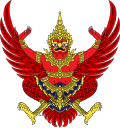This article has multiple issues. Please help improve it or discuss these issues on the talk page . (Learn how and when to remove these messages)
|
| Part of a series on the |
| Culture of Thailand |
|---|
 |
In Thailand, television broadcasting started on 24 June 1955 (in NTSC). [1] Color telecasts (PAL, System B/G 625 lines) were started in 1967, and full-time color transmissions were launched in 1975. As of November 2020, there are currently 21 digital (DVB-T2) TV channels in Thailand.